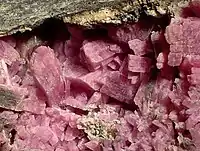Inesite
Inesite is a hydrous calcium manganese silicate mineral.[5] Its chemical formula is Ca2Mn7Si10O28(OH)2•5(H2O). Inesite is an inosilicate with a triclinic crystal system. It has a Mohs hardness of 5.5 to 6, and a specific gravity of 3.0. Its name originates from the Greek Ίνες (ines), "fibers" in allusion to its color and habit. [3]
| Inesite | |
|---|---|
 Inesite Crystals from Fengjishan Mine (Daye Copper Mine), Edong Mining District, Daye County, Huangshi Prefecture, Hubei Province, China. | |
| General | |
| Category | Inosilicates |
| Formula (repeating unit) | Ca2Mn7Si10O28(OH)2•5(H2O) |
| IMA symbol | Ins[1] |
| Strunz classification | 09.DL.05 |
| Dana classification | 66.3.3.1 |
| Crystal system | Triclinic |
| Space group | P1 (no.2) |
| Identification | |
| Color | Rose red, pink, orange-pink, orange-red-brown |
| Crystal habit | Massive, fibrous, radial, spherical |
| Cleavage | Perfect |
| Fracture | Irregular/Uneven |
| Tenacity | Brittle |
| Mohs scale hardness | 5.5 - 6 |
| Luster | Vitreous, Silky |
| Streak | White |
| Diaphaneity | Translucent |
| Specific gravity | 3.0 |
| Ultraviolet fluorescence | Non-fluorescent |
| Common impurities | Fe, Al, Mg, K |
| References | [2][3][4] |
Occurrence and distribution
Inesite occurs in hydrothermal replacement deposits of manganese-rich metamorphic rocks and serpentines.[6] It was first described in 1887 at Hilfe Gottes Mine, Oberscheld, Dillenburg, Dillenburg District, Hesse, Germany. Outside of the type locality, there are several notable localities of inesite, such as:[7][8]
- Wessels and N'Chwanning Mines, Kalahari Manganese Field, Northern Cape, South Africa where Inesite is associated with datolite, pectolite, apophyllite, ruizite, orientite and quartz.
- Broken Hill, New South Wales, Australia.
- Långban, Persberg, Värmland, Sweden.
- Kawazu Mine, Shizuoka Prefecture, Chubu Region, Honshu Island, Japan
- Hale Creek Mine, Trinity County, California, USA, where Inesite is associated with Rhodochrosite, bementite, and hausmannite.
- Fengjishan Mine (Daye Copper Mine), Edong Mining District, Daye County, Huangshi Prefecture, Hubei Province, China.
Inesite Gallery
 Bright red inesite with orange prehnite from N'Chwanning II Mine, Kuruman, Kalahari Manganese Field, North Cape, South Africa
Bright red inesite with orange prehnite from N'Chwanning II Mine, Kuruman, Kalahari Manganese Field, North Cape, South Africa Inesite from Hale Creek Mine,Trinity County, California, USA
Inesite from Hale Creek Mine,Trinity County, California, USA Inesite with yellow hubeite from Fengjishan Mine (Daye Copper Mine), Edong Mining District, Daye County, Huangshi Prefecture, Hubei Province, China
Inesite with yellow hubeite from Fengjishan Mine (Daye Copper Mine), Edong Mining District, Daye County, Huangshi Prefecture, Hubei Province, China Brown Inesite from Broken Hill, New South Wales, Australia
Brown Inesite from Broken Hill, New South Wales, Australia Inesite on top of orlymanite from Wessels Mine, Hotazel, Kalahari Manganese field, Northern Cape, South Africa
Inesite on top of orlymanite from Wessels Mine, Hotazel, Kalahari Manganese field, Northern Cape, South Africa
References
- Warr, L.N. (2021). "IMA–CNMNC approved mineral symbols". Mineralogical Magazine. 85 (3): 291–320. Bibcode:2021MinM...85..291W. doi:10.1180/mgm.2021.43. S2CID 235729616.
- Dave Barthelmy. "Inesite Mineral Data". webmineral.com. Retrieved 2019-01-26.
- "Inesite: Mineral information, data and localities". mindat.org. Retrieved 2019-01-26.
- Wan, C.; Ghose, S. (1978). "Inesite, a hydrated calcium manganese silicate with five-tetrahedral-repeat double chains". American Mineralogist. 63: 563–571.
- Chesterman, Charles (1978). The Audubon Society Field Guide to North American Rocks And Minerals. Knopf. p. 592.
- The Mineral Inesite
- "Inesite" (PDF). 18 August 2001. Retrieved 26 January 2019.
- http://www.minsocam.org/ammin/AM53/AM53_1614.pdf Inesite From the Broken Hill Lode, New South Wales, Australia
This article is issued from Wikipedia. The text is licensed under Creative Commons - Attribution - Sharealike. Additional terms may apply for the media files.